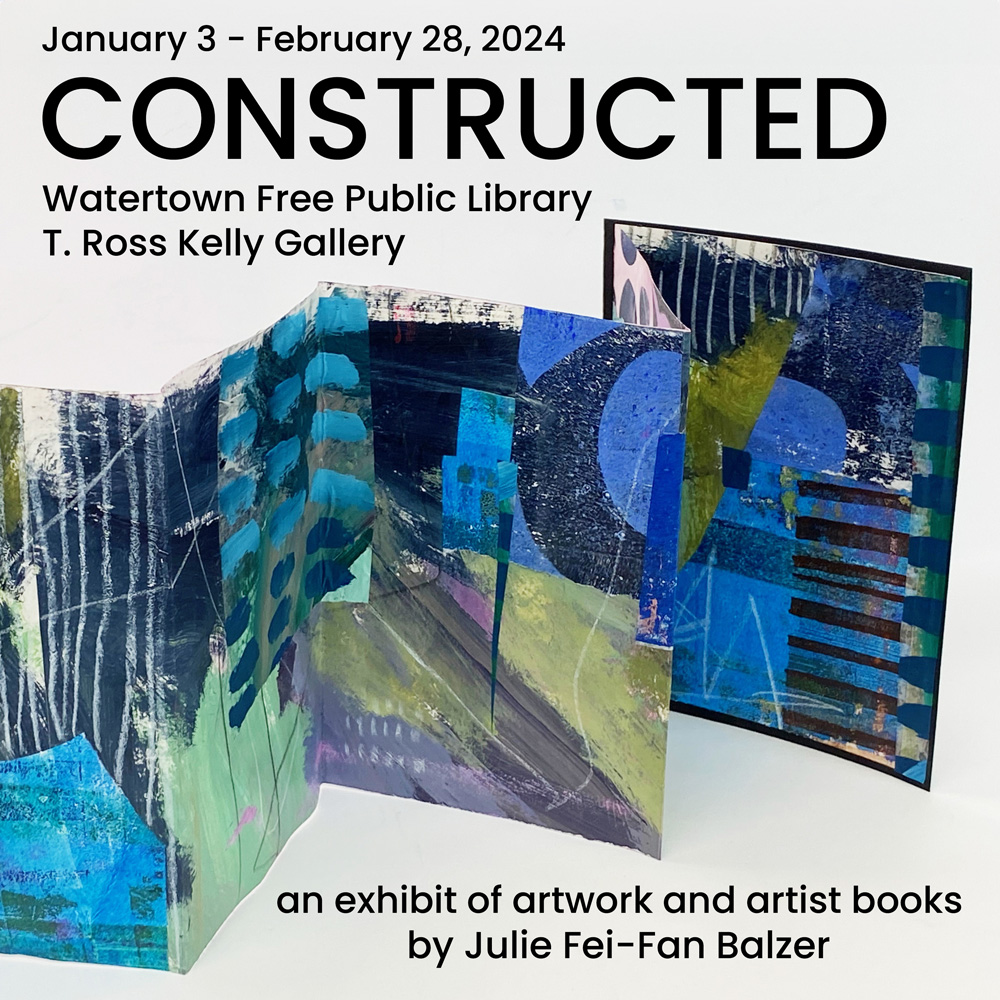Go offline with the Player FM app!
138: Julie’s “Constructed Exhibit” at the Library
Manage episode 398737379 series 28383
If you’ve ever wondered how an art exhibit comes together…this podcast details all of the things that went into planning mine.
You can visit the exhibit webpage HERE to see all of the art in the exhibit and read a bit about each piece.
Some thoughts I have on what makes a “good” exhibit:
- It’s good for you and good for the venue – meaning: you both get what you want. So what do you want?
- It’s authentic to you. Andy J. Pizza/Creative Pep Talk Podcast – True not New.
- A cohesive and well-defined theme or concept helps create a narrative or connection between the artworks. It gives the exhibit a sense of purpose and coherence.
- Thoughtful presentation, including proper lighting, framing, and spacing, can significantly enhance the visual impact of the artwork. The physical environment should complement the art without overshadowing it. Organizing the artwork in a way that enhances the overall viewing experience. This includes thoughtful arrangement, consideration of flow, and creating a visual or conceptual dialogue between pieces.
- Variety can make an exhibit more interesting and appealing to a broader audience. Diversity in artistic expressions adds richness to the overall experience. I did this really well by accident.
- The quality of the artwork is fundamental. Exhibits that feature high-caliber, innovative, and well-executed pieces are more likely to capture the attention and admiration of the audience.
- Museums often try to provide opportunities for the audience to engage with the art, such as interactive installations, artist talks, or guided tours. I’m hoping the guest book is a little bit of an interactive opportunity.
- Educational Components: Including informative materials, such as artist statements, exhibition guides, or wall labels, can provide context and help visitors better understand and appreciate the artworks.
- If a tree falls in the forest and no one is there to hear it, does it make a sound? There needs to be some effective promotion of the exhibit.
Ultimately, a good art exhibit is one that creates a memorable and engaging experience for the audience. As always, I hope you found this podcast both useful and entertaining.
Links:
- Tip the Artist: PayPal.Me/balzerdesigns
- Sign up for the Friday FREE newsletter: https://forms.feedblitz.com/bco
- Monthly Membership: https://bit.ly/JulieMembership
- Take an online class: https://balzerdesigns.com/Classroom/
- Shop: https://www.juliebalzer.com/shop.html
- Let’s connect on instagram: https://www.instagram.com/balzerdesigns/
- Favorite Things: https://www.amazon.com/shop/balzerdesigns
Thanks for listening and subscribing!
88 episodes
Manage episode 398737379 series 28383
If you’ve ever wondered how an art exhibit comes together…this podcast details all of the things that went into planning mine.
You can visit the exhibit webpage HERE to see all of the art in the exhibit and read a bit about each piece.
Some thoughts I have on what makes a “good” exhibit:
- It’s good for you and good for the venue – meaning: you both get what you want. So what do you want?
- It’s authentic to you. Andy J. Pizza/Creative Pep Talk Podcast – True not New.
- A cohesive and well-defined theme or concept helps create a narrative or connection between the artworks. It gives the exhibit a sense of purpose and coherence.
- Thoughtful presentation, including proper lighting, framing, and spacing, can significantly enhance the visual impact of the artwork. The physical environment should complement the art without overshadowing it. Organizing the artwork in a way that enhances the overall viewing experience. This includes thoughtful arrangement, consideration of flow, and creating a visual or conceptual dialogue between pieces.
- Variety can make an exhibit more interesting and appealing to a broader audience. Diversity in artistic expressions adds richness to the overall experience. I did this really well by accident.
- The quality of the artwork is fundamental. Exhibits that feature high-caliber, innovative, and well-executed pieces are more likely to capture the attention and admiration of the audience.
- Museums often try to provide opportunities for the audience to engage with the art, such as interactive installations, artist talks, or guided tours. I’m hoping the guest book is a little bit of an interactive opportunity.
- Educational Components: Including informative materials, such as artist statements, exhibition guides, or wall labels, can provide context and help visitors better understand and appreciate the artworks.
- If a tree falls in the forest and no one is there to hear it, does it make a sound? There needs to be some effective promotion of the exhibit.
Ultimately, a good art exhibit is one that creates a memorable and engaging experience for the audience. As always, I hope you found this podcast both useful and entertaining.
Links:
- Tip the Artist: PayPal.Me/balzerdesigns
- Sign up for the Friday FREE newsletter: https://forms.feedblitz.com/bco
- Monthly Membership: https://bit.ly/JulieMembership
- Take an online class: https://balzerdesigns.com/Classroom/
- Shop: https://www.juliebalzer.com/shop.html
- Let’s connect on instagram: https://www.instagram.com/balzerdesigns/
- Favorite Things: https://www.amazon.com/shop/balzerdesigns
Thanks for listening and subscribing!
88 episodes
All episodes
×Welcome to Player FM!
Player FM is scanning the web for high-quality podcasts for you to enjoy right now. It's the best podcast app and works on Android, iPhone, and the web. Signup to sync subscriptions across devices.





